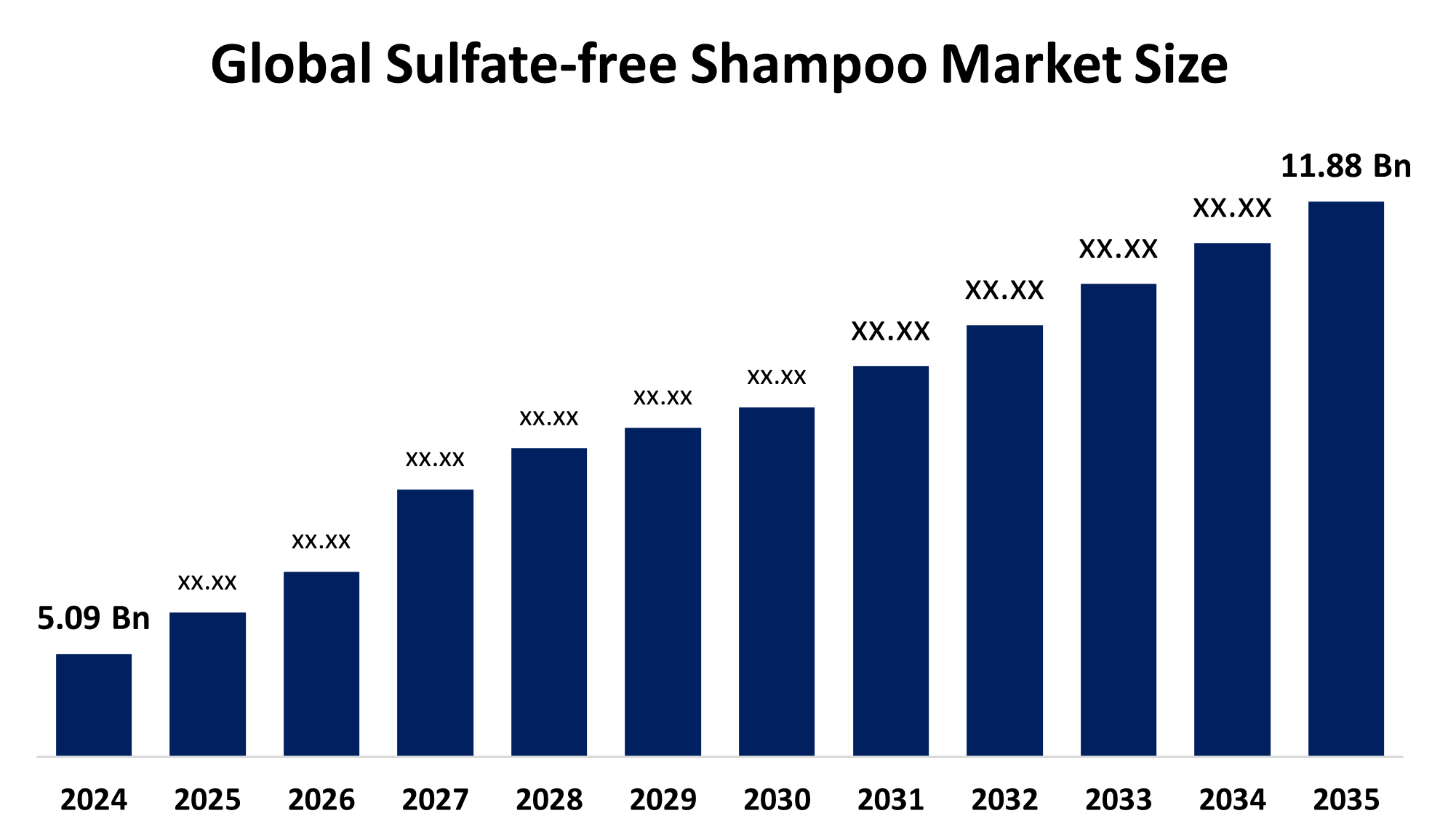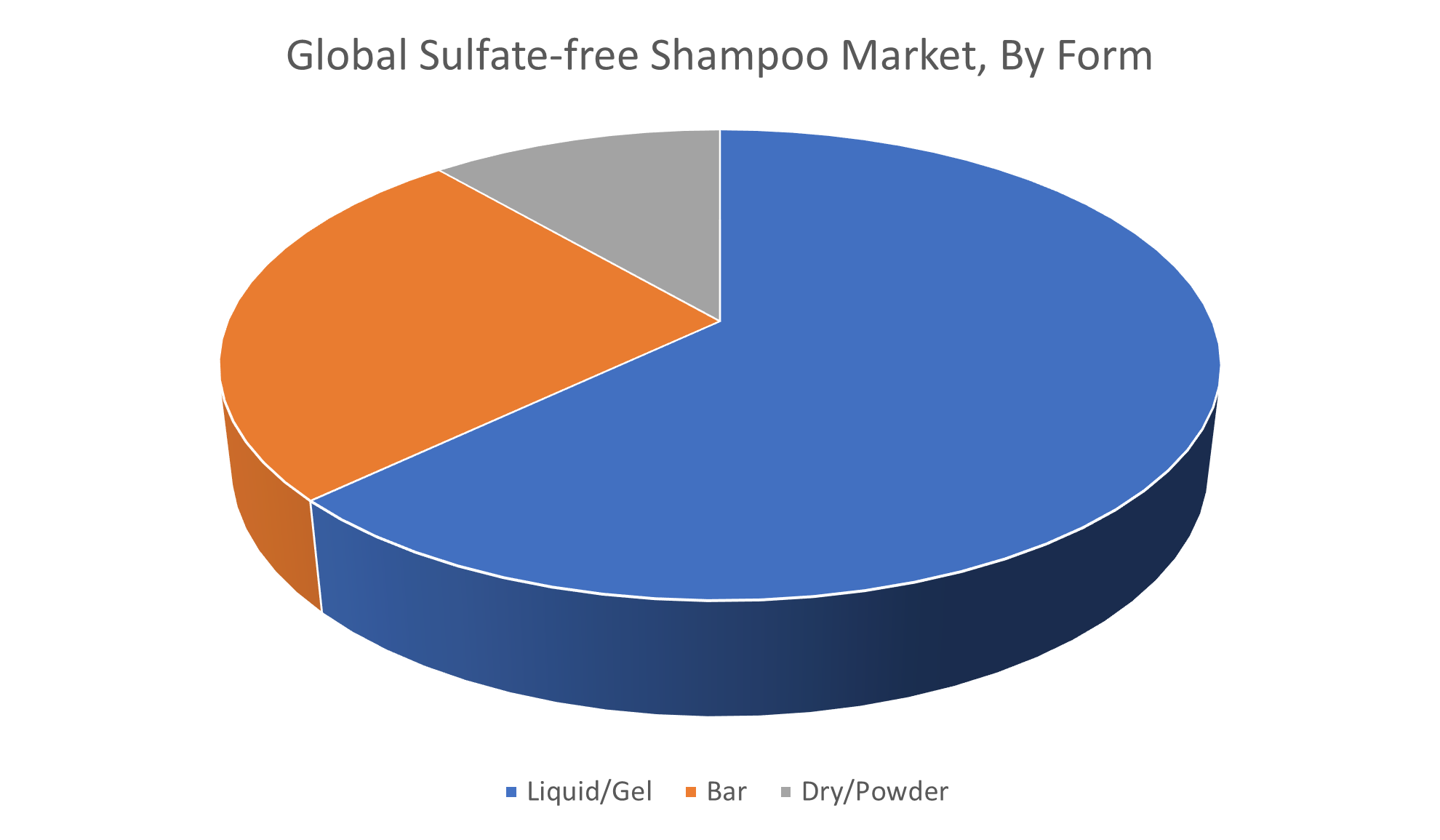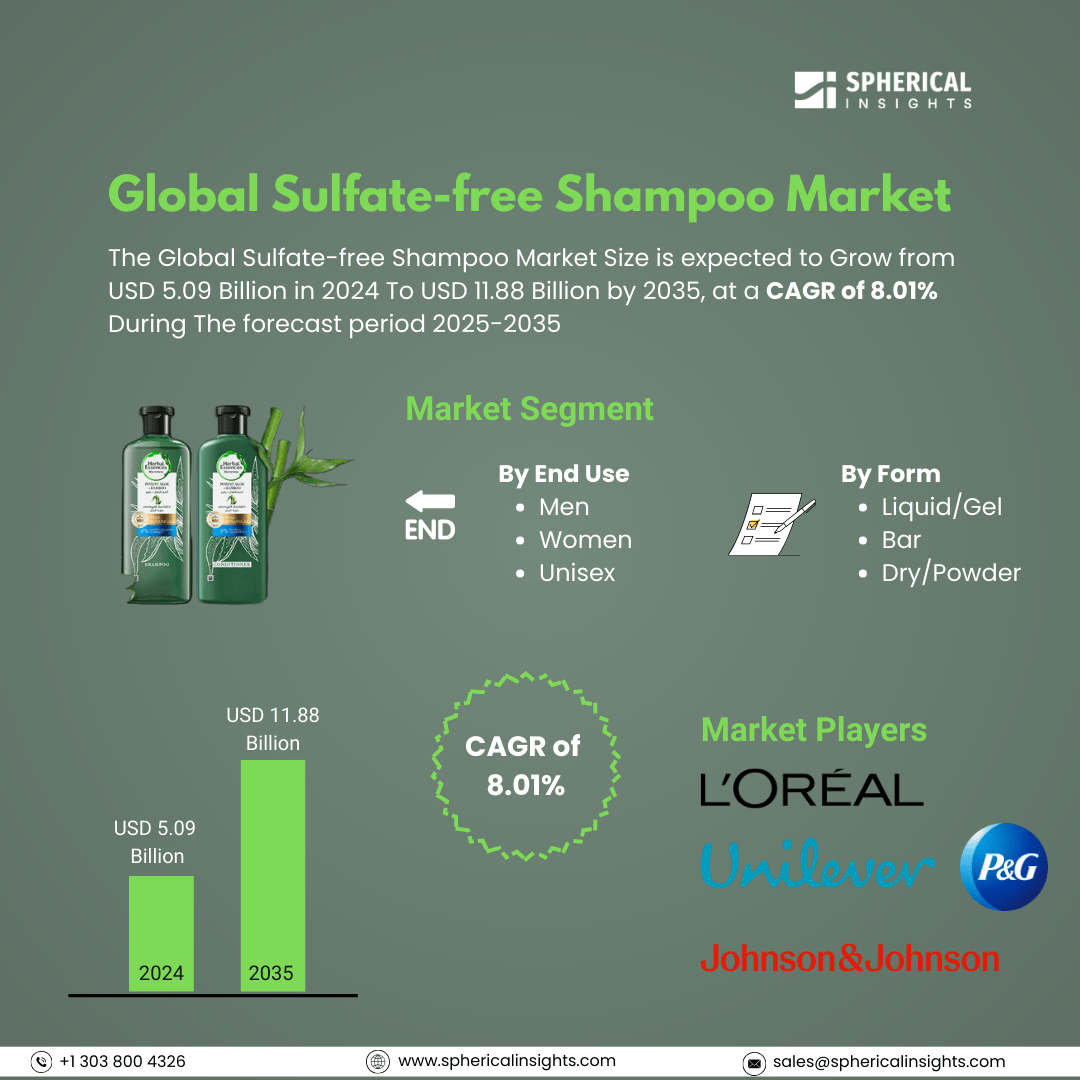Global Sulfate-free Shampoo Market Insights Forecasts To 2035
- The Global Sulfate-free Shampoo Market Size Was Estimated at USD 5.09 Billion in 2024
- The Market Size is Expected to Grow at a CAGR of around 8.01% from 2025 to 2035
- The Worldwide Sulfate-free Shampoo Market Size is Expected to Reach USD 11.88 Billion by 2035
- Asia Pacific is expected To Grow the fastest during the forecast period.

Sulfate-free Shampoo Market
The global sulfate-free shampoo market is growing steadily, driven by increasing awareness of hair health and a preference for gentler formulations. Sulfate-free shampoos are made without harsh surfactants such as sodium lauryl sulfate (SLS) and sodium laureth sulfate (SLES), which are commonly associated with dryness, irritation, and color fading. These products are widely chosen by consumers seeking milder alternatives that preserve natural oils and support overall scalp health. The market encompasses a broad range of offerings tailored to different hair types and needs, including moisturizing, volumizing, and color-protecting variants. Available in various formats like liquid, gel, and increasingly popular bar forms, sulfate-free shampoos are sold through multiple distribution channels including supermarkets, pharmacies, salons, and online platforms. A mix of well-established personal care companies and niche brands compete in the space, promoting constant product innovation and clean-label positioning.
Attractive Opportunities in the Sulfate-free Shampoo Market
- Development of niche sulfate-free formulas for specific hair types and scalp conditions
- Rising demand for eco-friendly, waterless, and solid shampoo formats
- Growth in vegan, cruelty-free, and clean-label product offerings
Global Sulfate-free Shampoo Market Dynamics
DRIVER: Rising awareness of the potential side effects of traditional shampoos
The global sulfate-free shampoo market is driven by a rising awareness of the potential side effects of traditional shampoos containing harsh sulfates like SLS and SLES. Consumers are increasingly seeking gentle, non-irritating formulas that preserve natural hair oils and prevent scalp dryness or damage. The growing popularity of organic and clean beauty products has further boosted demand for sulfate-free options, particularly among individuals with sensitive skin or color-treated hair. Social media influence and endorsements by dermatologists and haircare professionals have also played a key role in educating consumers about the benefits of sulfate-free formulations. Additionally, the expansion of e-commerce platforms has made these specialized products more accessible to a broader audience. Innovations in natural and plant-based ingredients have improved the effectiveness of sulfate-free shampoos, making them more appealing to mainstream users. The overall shift toward wellness and sustainable living continues to support market growth as more consumers prioritize health-conscious personal care choices.
RESTRAINT: Switching to sulfate-free products can take time
One main issue is that these shampoos usually don’t lather as much as regular ones, making some people feel like their hair isn’t being cleaned properly. Also, switching to sulfate-free products can take time, and during that period, hair may feel greasy or harder to manage, which can be frustrating for users. These shampoos are often more expensive too, which can make them less attractive to people who are looking for budget-friendly options. In some cases, sulfate-free formulas may not work well for all hair types, especially for people who use a lot of styling products. Another problem is that not everyone understands what “sulfate-free” means, and labels can sometimes be confusing. Lastly, making good-quality sulfate-free shampoos can be harder and more costly for companies, especially when they try to use natural ingredients that still work well.
OPPORTUNITY: Development of specialized sulfate-free formulas for niche needs
The sulfate-free shampoo market holds several unique opportunities beyond common growth drivers. One promising area is the development of specialized sulfate-free formulas for niche needs such as curly hair, scalp conditions, or post-chemical treatments, offering targeted solutions for underserved segments. There is also growing interest in waterless or solid shampoo formats, which align with eco-conscious values and offer travel-friendly convenience. Collaborations with salons and professional stylists can boost credibility and introduce premium sulfate-free lines to new customers. Moreover, rising demand for vegan and cruelty-free personal care products opens doors for brands to expand their ethical offerings. Another key opportunity lies in educating consumers through clear labeling and transparency about ingredients and benefits, helping build trust and loyalty. Finally, brands that embrace biodegradable packaging and carbon-neutral manufacturing may stand out in a crowded market, attracting environmentally aware shoppers looking for sustainable hair care solutions that go beyond just being sulfate-free.
CHALLENGES: Some brands also use false or unclear marketing to make their products
One challenge is making sure the shampoo works well while only using natural or plant-based ingredients, which can sometimes affect how long the product lasts or how well it performs. Also, different countries have different rules about what “sulfate-free” means, which can make it hard for brands to sell their products globally. As more companies enter the market, it’s getting harder for brands to stand out, and customers may get confused by too many similar options. Some brands also use false or unclear marketing to make their products seem more natural than they are, which can reduce consumer trust. Another issue is that sulfate-free shampoos can struggle to remove heavy buildup from styling products or hard water. Finally, in less developed areas, many people still aren’t aware of the benefits of switching to sulfate-free products.
Global Sulfate-free Shampoo Market Ecosystem Analysis
The global sulfate-free shampoo market ecosystem includes raw material suppliers, manufacturers, packaging providers, distributors, retailers, and end consumers. It is supported by e-commerce platforms, salons, and marketing agencies that promote clean and gentle hair care solutions. Regulatory bodies oversee safety and labeling standards, while consumer demand drives innovation toward natural, vegan, and eco-friendly formulations. The ecosystem is highly dynamic, shaped by trends in health, sustainability, and beauty preferences.
Based on the end use, the women’s segment led the sulfate-free shampoo market with a significant revenue share over the forecast period

The women’s segment led the global sulfate-free shampoo market, accounting for a significant share of the overall revenue during the forecast period. This dominance is attributed to the higher demand among women for hair care products that are gentle, safe for color-treated hair, and free from harsh chemicals. Women are more likely to prioritize scalp health, hair strength, and cosmetic appeal, leading to greater adoption of sulfate-free formulations. Additionally, increased awareness of clean beauty trends, along with targeted marketing and product innovations aimed at female consumers, has further strengthened the segment’s position in the market.
Based on the form, the liquid/gel segment dominated the sulfate-free shampoo market over the forecast period

The segment's strong performance is primarily due to consumer familiarity, ease of application, and wide availability across retail and online platforms. Liquid and gel shampoos are often preferred for their ability to spread easily through the hair, create sufficient lather (even in sulfate-free versions), and deliver consistent cleansing results. Manufacturers also tend to focus more on liquid formulations when launching new sulfate-free products, contributing to greater visibility and market share. Additionally, these forms offer better compatibility with a variety of packaging types, such as pump bottles and tubes, enhancing convenience for users and reinforcing their popularity in the market.
Europe is anticipated to hold the largest market share of the sulfate-free shampoo market during the forecast period
Europe is anticipated to hold the largest market share of the sulfate-free shampoo market during the forecast period. This dominance is driven by a high level of consumer awareness regarding personal care ingredients and a strong preference for clean, natural, and organic beauty products. European consumers are increasingly seeking hair care solutions that are free from harsh chemicals like sulfates, parabens, and silicones. Additionally, the presence of stringent regulations around cosmetic product safety and labeling supports the growth of sulfate-free offerings. The region also benefits from a well-established beauty and personal care industry, with both international and local brands actively promoting sulfate-free formulations. Growing environmental consciousness and demand for cruelty-free and vegan products further contribute to the region’s leading position in the market.
Asia Pacific is expected to grow at the fastest CAGR in the sulfate-free shampoo market during the forecast period
Asia Pacific is expected to grow at the fastest CAGR in the sulfate-free shampoo market during the forecast period. This rapid growth is fueled by rising disposable incomes, increased awareness of personal grooming, and a growing shift toward natural and chemical-free beauty products. The influence of social media, beauty influencers, and global clean beauty trends is significantly impacting consumer preferences in countries like China, India, Japan, and South Korea. Additionally, the expansion of urban populations and improved access to a variety of hair care brands through e-commerce platforms are boosting market penetration. The region's diverse hair types and climate conditions also create a strong demand for customized sulfate-free solutions. As consumers become more health-conscious and environmentally aware, the demand for gentle, sustainable hair care options continues to rise, positioning Asia Pacific as the fastest-growing market segment in the global sulfate-free shampoo industry.
Recent Development
- In November 2024, CeraVe, a prominent beauty brand in the U.S., introduced CeraVe anti-dandruff shampoo and conditioner. Anti-Dandruff Shampoo is formulated with 1% Pyrithione Zinc, effectively eliminating up to 100% of visible flakes. This pH-balanced, allergy-tested formula effectively treats dandruff to help promote overall scalp health. In addition, it is free of sulfates, MIT, dyes, parabens, and fragrance.
Key Market Players
KEY PLAYERS IN THE SULFATE-FREE SHAMPOO MARKET INCLUDE
- L’Oréal S.A.
- Unilever plc
- Procter & Gamble Co. (P&G)
- Johnson & Johnson Services, Inc.
- Henkel AG & Co. KGaA
- The Estée Lauder Companies Inc.
- Natura & Co.
- Kao Corporation
- Amway Corporation
- Function of Beauty
- Others
Market Segment
This study forecasts revenue at global, regional, and country levels from 2020 to 2035. Spherical Insights has segmented the sulfate-free shampoo market based on the below-mentioned segments:
Global Sulfate-free Shampoo Market, By End Use
Global Sulfate-free Shampoo Market, By Form
- Liquid/Gel
- Bar
- Dry/Powder
Global Sulfate-free Shampoo Market, By Regional Analysis
- North America
- Europe
- Germany
- UK
- France
- Italy
- Spain
- Russia
- Rest of Europe
- Asia Pacific
- China
- Japan
- India
- South Korea
- Australia
- Rest of Asia Pacific
- South America
- Brazil
- Argentina
- Rest of South America
- Middle East & Africa
- UAE
- Saudi Arabia
- Qatar
- South Africa
- Rest of the Middle East & Africa






